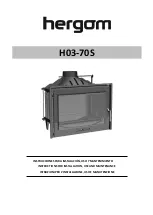
11
Advantages:
The stove will not use the room air, and due
to this you will not lose hot room air, and high
air renovation ratios will not be necessary.
In case of low pressure inside the room, the
exhaust will never get into the room.
CO generation inside the room and its
dangerous consequences will be avoided.
Always bear in mind that the air inlet to the
appliance is made by means of the connector. It
should never be possible to cap this inlet. Either
on the stove or on the outside. Nor should it be
possible for the connection tube to be crushed or
obstructed by something. A grating is required on
the intake.
The position of the air intake should be protected
from the wind to avoid a possible positive or
negative pressurisation of the combustion.
Please note that this accessory is a connector that
serves to facilitate the installation and has no
control system by itself. There are control systems
on the market that can be installed together with
this accessory to control the air intake and to
complete a proper installation.
When you install an air intake from outside you
should always have the primary air valve closed
(Fig. 2).
The diameter of the connector pipe is prepared
for installing pipes of 80 mm in diameter, which is
a standard measure. The installation of the
connector is easy and you can see it in this manual
in section 10.
5. CLEANING
FRONT AND PAINTED CAST IRON DOOR.
Always use dry cloths.
GLASS ON THE DOOR.
Never attempt to clean the glass while the stove is
in operation. We recommend that you use
Hergóm glass cleaner when it is cold.
Replacement. The glass on your stove is
manufactured especially for wood-burning stoves.
If it breaks it should be replaced with glass that
has the same characteristics. Please contact the
authorised Technical Support Service to provide
the proper glass, accompanied by the assembly
instructions and gaskets.
GASKETS AND SEAL
At the start and halfway through a season it is
recommended to carry out a visual check on the
condition of the gaskets (doors, glass, etc.) and
seal of the parts, in case it is necessary to replace
or repair them.
ASH.
The cast iron stove is equipped with a ash pan
located under the base of the stove.
To remove the ashes, remove the andiron and cast
iron grill (rectangular cover) which hides it using a
protective glove, and remove it from the stove so
as not to hinder the cleaning (Fig. 7 and 8).
Move the ash to the ash pan with a scraper or a
brush. Remove the ash pan from its housing and
clean it of ash (Fig. 9).
For safety reasons the ash pan cannot be
removed with the door of the stove closed.
The responsibility for manufacturing defects will
be submitted to the criterion and verification of
the company's technicians, but is limited to the
repair or replacement of its products, in
accordance with the warranty that comes with
each product.
Summary of Contents for H03-70S
Page 21: ...21 10 11 12 15 16 C D 14 13...
Page 24: ...24 11 DIMENSIONES GENERALES GENERAL DIMENSIONS DIMENSIONI...
Page 26: ...26 13 DESPIECE Y REPUESTOS DISASSEMBLY AND SPARE PARTS ESPLOSO E RICAMBI...
Page 27: ...27...
Page 28: ...28 C...
Page 30: ...30 PLACA DE CARACTERISTICAS SPECIFICATIONS PLATE TARGHETTA DELLE CARATTERISTICHE...
Page 31: ...31...












































